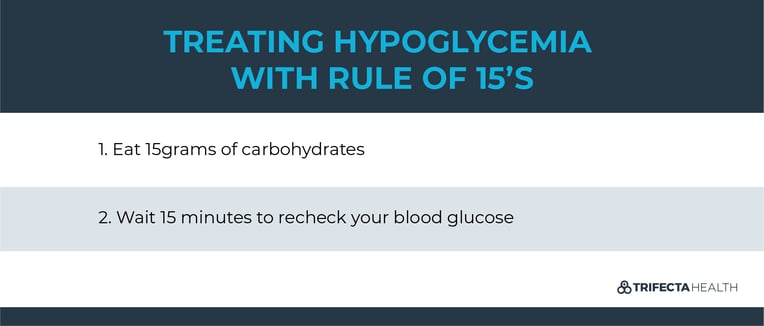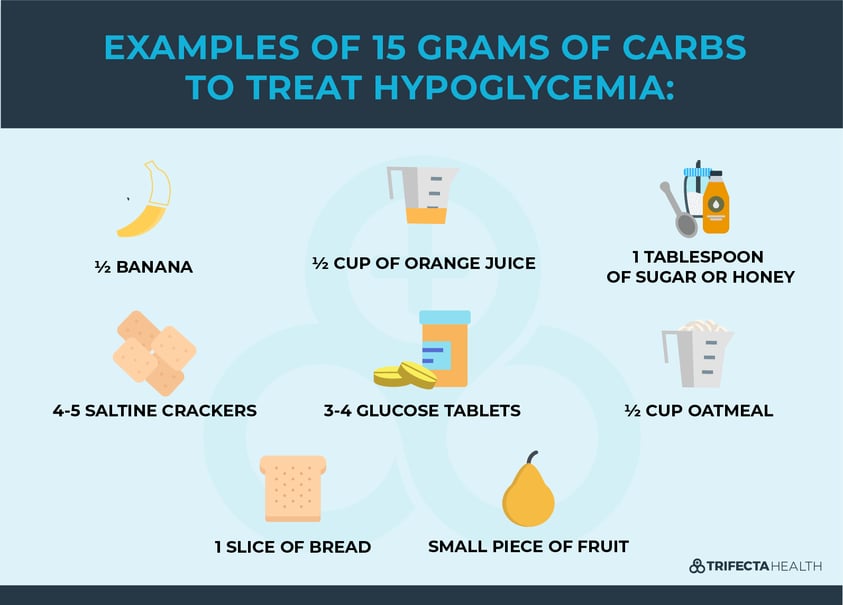Hypoglycemia is one of the most common complications of diabetes treatment.
While it’s often easy to fix, low blood glucose (hypoglycemia) can be dangerous if left untreated. If you or a family member has diabetes, it’s important to learn how to recognize and treat hypoglycemia.
What is Hypoglycemia?
Hypoglycemia means low blood glucose levels.
Hypoglycemia Definition
While hypoglycemia always refers to low blood sugar, the number that defines how low is ‘too low’ can be somewhat variable.
In diabetics blood glucose <70 milligrams per deciliter (mg dl) is considered hypoglycemic.
In people without diabetes, this number can become somewhat more blurred and the term hypoglycemia can be used to be more based on symptoms. This is because different people can have slight variations in their metabolisms.
For example, if someone has symptoms of hypoglycemia and their glucose is 70 then it is called hypoglycemia. But if a different healthy individual has a blood sugar of 67 and feels well this may not be considered true hypoglycemia.
Sugars below 50 mg/dl are generally accepted as hypoglycemia whether symptoms are present or not. Newborns are an exception to this rule and can have sugars as low as 40 mg/dl before they are considered hypoglycemic.
Hypoglycemia Symptoms
Symptoms of hypoglycemia can vary depending on the person. Some of the most common symptoms people may experience with low blood sugar are listed below.
- Fatigue
- Hunger
- Dizziness
- Sweating
- Headache
- Confusion
- Weakness
- Coma
- Seizure
- Neurological deficits
- Death (if left untreated)
Hypoglycemia Causes
The most common cause of hypoglycemia in diabetics is medications. Both insulin and oral antiglycemic medications can cause dangerously low blood sugar. Therefore, people with type 1 diabetes are more likely to become hypoglycemic as they all require long term insulin to manage their disease.
Diabetics on medications who become hypoglycemic often have one of the following triggers.
- Increased Medication Dosing
- Increased Exercise / Physical Activity
- Decreased Food Intake
- Drinking Alcohol
To be complete, there are other more rare causes of hypoglycemia that include other medications, severe infections and other chronic health conditions. These other health conditions include but are not limited to kidney and liver failure as well as thyroid conditions.
Hypoglycemia Treatment
Hypoglycemia is only dangerous if left untreated. Early identification and treatment are key.

Foods for Hypoglycemia
The simplest way to raise your blood glucose is to eat carbs. Consuming 10-20 grams of carbohydrates can raise glucose levels and improve symptoms within minutes. This is the equivalent of 3-4 ounces of juice.
It’s important for diabetics to not eat too many more carbohydrates than this at first in order to avoid overshooting and developing complications from hyperglycemia.
In order to prevent sugars from going to high, the American Diabetes Association recommends 15 grams of carbohydrates and rechecking after 15 minutes to reassess the need for additional carbohydrates. They call this the ‘rule of 15’s’.

These sources of sugar act quickly to treat low blood sugar levels. People with diabetes who use insulin or certain other diabetes medicines should carry at least one of these items at all times.
Hypoglycemia Medication
If someone is in a diabetic coma, or otherwise too confused or unable to eat for any reason, they can be given medications to raise their blood sugar. Options for this include dextrose, glucagon, and octreotide.
Depending on how severe the low blood sugar is and what is causing the low blood sugar, medications may need to be given multiple times.
Dextrose (ie: D50)
Simply put: D50 is a shot of sugar.
While the effects of dextrose wear off quickly, they also start acting quickly - and can be life saving. Dextrose is commonly used by paramedics and hospitals to raise blood sugar quickly.
Glucagon
Everyone who is prescribed insulin should have a glucagon emergency kit. It helps to increase blood sugar and can be given by injection with or without an IV. Glucagon is naturally found in our body and works by converting stored glucose (glycogen) into free and active glucose.
Simply put, glucagon increases the glucose in your blood by releasing it from your body’s glucose storage.
Glucagon can be given at home and may be administered in the form of an injection by the individual with diabetes who is suffering from hypoglycemia. It may also be administered by a family member or friend, and also of course used by paramedics and in hospitals to help people with hypoglycemia.
Octreotide
Octreotide is a special medication that is used when blood sugars are low in people who are taking sulfonylureas (ie: glipizide, glyburide). These medications work by stimulating the release of insulin from the pancreas. Octreotide helps to counteract sulfonylureas by preventing the pancreas from releasing insulin. Octreotide is usually only used in hospitals to treat hypoglycemia.
How to Prevent Hypoglycemia
Learning how to prevent and treat hypoglycemia is critical to the daily life of a diabetic.
1) Take Your Medications as Prescribed
Unless you have a specific plan with your doctor don’t change the medication you’re taking. Don’t ever increase your medication dosing or take double the medication, even if you missed a dose.
2) Blood Sugar Checks
Check your blood glucose frequently to ensure the medicine isn’t too strong for your current needs. Talk with your doctor if your blood sugars are running low. Have a plan that you’ve developed with your doctor of what to do with your medication dosing if your sugars are low.
3) Learn What Lowers Blood Glucose
It’s also important to be aware of other contributing factors to lowering your blood sugar. People that use insulin can learn to better predict how much insulin they will need based on their personal daily fluctuations in these variables.
Potential Triggers for Hypoglycemia
- Eating fewer carbohydrates
- Eating fewer calories
- Infections
- Exercise
- Stress
- Certain medications
4) Recognize Your Signs and Symptoms of Hypoglycemia
Everyone may experience slightly different symptoms from hypoglycemia. It’s important to recognize what your symptoms are when your blood sugar is low so you can catch (and treat) it early before it becomes more severe.
5) Be Cautious of Drinking Alcohol
If you choose to drink alcohol, be cautious of your blood sugars. Excessive drinking can be dangerous, especially for type 1 diabetics. Eat a meal with a low to moderate amount of alcohol and check your sugars to ensure you don’t need to add additional management.
6) Develop a Plan for Medication Changes
You should work with your doctor to develop a plan of how to change your medication doses if your sugars are running too low. This allows you to pre-emptively adjust your medications based on the needs of your body and can prevent dangerous complications.
7) Be Prepared to Treat Hypoglycemia
You should always be prepared for to treat hypoglycemia. If you’re a type 1 diabetic, this is particularly important. Having simple carbohydrates on hand to follow the rule of 15’s if hypoglycemia starts is a must. And all diabetic taking insulin should have an emergency hypoglycemia glucagon kit available and know how to use it during episodes of moderate to severe hypoglycemia.